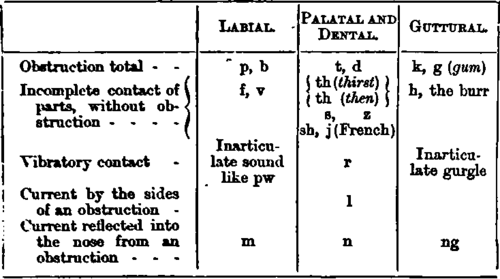198. Speech
Description
This section is from the book "Animal Physiology: The Structure And Functions Of The Human Body", by John Cleland. Also available from Amazon: Animal Physiology, the Structure and Functions of the Human Body.
198. Speech
Speech is to be carefully distinguished from voice. Voice without speech is an inarticulate sound; speech without voice is a whisper. Speech is accomplished by the modifying action of various organs on the expiratory currents of air passing through the mouth. The tongue is by no means the exclusive, nor even the principal organ of speech. In ordinary language, speech is referred to as the use of the tongue, and taste as the use of the palate; and even the word "language," etymologically, means action of the tongue. Yet the palate has little to do with taste, the tongue being the only part in which that sense resides; while the palate, the lips, the fauces, and even the nose are organs of speech as well as the tongue, and persons from whom the tongue has been completely removed by operation continue to speak sufficiently plainly to be understood. The sounds of the various vowels are made by varying the shape of the aperture through which the air escapes by the mouth; the consonants, on the other hand, are sounded by placing obstructions of different kinds, and in different places, in the way of the current of air.
In the following table an attempt is made to arrange all the possible consonant sounds, according to their mechanism, as labial, palatal or dental, and guttural. It will be observed that the fore parts of the tongue take no part in the formation of any labial or guttural sound; and that in the dental series there are two in which the tongue takes no part, namely, sh and French j, the only two sounds in which the lower teeth take part, The upper teeth take part in two sounds ranged with the labials, namely, f and v. Corresponding hard and soft sounds are placed together in each series in the table. The consonant sounds w and y are omitted, because they are simply a rapidly sounded ou and ee.

Continue to:
- prev: Chapter XVI. Voice And Speech
- Table of Contents
- next: 199. The Simplest Method Of Multiplication
